Biodegradable and Toughened Composite of Poly(Propylene Carbonate)/Thermoplastic Polyurethane (PPC/TPU): Effect of Hydrogen Bonding
Abstract
:1. Introduction
2. Results and Discussion
2.1. FTIR Investigation
2.2. Morphology Observation
2.3. Thermal Behaviors
2.4. Mechanical Properties
2.5. Toughening Mechanism
2.6. Dynamic Mechanical Analysis
3. Materials and Methods
3.1. Materials
3.2. Preparation of PPC/TPU Blends
3.3. Fourier Transform Infrared (FTIR) Spectra
3.4. Scanning Electron Microscopy (SEM) Observation
3.5. Differential Scanning Calorimetry (DSC) Investigation
3.6. Vicat Softening Temperature
3.7. Static Tensile Properties
3.8. Charpy Impact Strength
3.9. Dynamic Mechanical Analysis
4. Conclusions
Author Contributions
Acknowledgments
Conflicts of Interest
References
- Inoue, S.; Tsuruta, T.; Kobayash, M.; Koinuma, H. Reactivities of Some Organozinc Initiators for Copolymerization of Carbon Dioxide and Propylene Oxide. Die. Makromol. Chem. 1972, 155, 61–73. [Google Scholar] [CrossRef]
- Darensbourg, D. Making Plastics from Carbon Dioxide: Salen Metal Complexes as Catalysts for the Production of Polycarbonates from Epoxides and CO2. J. Chem. Rev. 2007, 107, 2388–2410. [Google Scholar] [CrossRef] [PubMed]
- Luinstra, G.A. Poly(Propylene Carbonate), Old Copolymers of Propylene Oxide and Carbon Dioxide with New Interests: Catalysis and Material Properties. Polym. Rev. 2008, 48, 192–219. [Google Scholar] [CrossRef]
- Inoue, S.; Tsuruta, T. Synthesis and thermal degradation of carbon dioxide-epoxide copolymer. Appl. Polym. Symp. 1975, 26, 257. [Google Scholar]
- Ren, W.M.; Zhang, X.; Liu, Y.; Li, J.F.; Wang, H.; Lu, X.B. Highly Active, Bifunctional Co(III)-Salen Catalyst for Alternating Copolymerization of CO2 with Cyclohexene Oxide and Terpolymerization with Aliphatic Epoxides. Macromolecules 2010, 43, 1396–1402. [Google Scholar] [CrossRef]
- Song, P.F.; Xiao, M.; Du, F.G.; Wang, S.J.; Gan, L.Q.; Liu, G.Q.; Meng, Y.Z. Synthesis and properties of aliphatic polycarbonates derived from carbon dioxide, propylene oxide and maleic anhydride. J. Appl. Polym. Sci. 2008, 109, 4121–4129. [Google Scholar] [CrossRef]
- Seong, J.E.; Na, S.J.; Cyriac, A.; Kim, B.W.; Lee, B.Y. Terpolymerization of CO2 with Propylene Oxide and ε-Caprolactone Using Zinc Glutarate Catalyst. Macromolecules 2003, 36, 8210–8212. [Google Scholar] [CrossRef]
- Zeng, S.S.; Wang, S.J.; Xiao, M.; Han, D.M.; Meng, Y.Z. Preparation and properties of biodegradable blend containing poly (propylene carbonate) and starch acetate with different degrees of substitution. Carbohydr. Polym. 2011, 86, 1260–1265. [Google Scholar] [CrossRef]
- Ge, X.C.; Li, X.H.; Zhu, Q.; Li, L.; Meng, Y.Z. Preparation and properties of biodegradable poly(propylene carbonate)/starch composites. Polym. Eng. Sci. 2004, 44, 2134–2140. [Google Scholar] [CrossRef]
- Tao, J.; Song, C.J.; Cao, M.F.; Hu, D.; Liu, L.; Liu, N.; Wang, S.F. Thermal properties and degradability of poly(propylene carbonate)/poly(β-hydroxybutyrate-co-β-hydroxyvalerate) (PPC/PHBV) blends. Polym. Degrad. Stab. 2009, 94, 575–583. [Google Scholar] [CrossRef]
- Yang, D.Z.; Hu, P. Miscibility, crystallization, and mechanical properties of poly(3-hydroxybutyrate) and poly(propylene carbonate) biodegradable blends. J. Appl. Polym. Sci. 2008, 109, 1635–1642. [Google Scholar] [CrossRef]
- Ma, X.F.; Yu, J.G.; Wang, N. Compatibility characterization of poly (lactic acid)/poly (propylene carbonate) blends. J. Polym. Sci. Part B Polym. Phys. 2006, 44, 94–101. [Google Scholar] [CrossRef]
- Pang, M.Z.; Qiao, J.J.; Jiao, J.; Wang, S.J.; Xiao, M.; Meng, Y.Z. Miscibility and properties of completely biodegradable blends of poly(propylene carbonate) and poly(butylene succinate). J. Appl. Polym. Sci. 2008, 107, 2854–2860. [Google Scholar] [CrossRef]
- Jiao, J.; Wang, S.J.; Xiao, M.; Xu, Y.; Meng, Y.Z. Processability, property, and morphology of biodegradable blends of poly (propylene carbonate) and poly (ethylene-co-vinyl alcohol). Polym. Eng. Sci. 2007, 47, 174–180. [Google Scholar] [CrossRef]
- Simmons, A.; Hyvarinen, J.; Poole-Warren, L. The effect of sterilisation on a poly (dimethylsiloxane)/poly (hexamethylene oxide) mixed macrodiol-based polyurethane elastomer. Biomaterials 2006, 27, 4484–4497. [Google Scholar] [CrossRef] [PubMed]
- Lebedev, E.V.; Ishchenko, S.S.; Denisenko, V.D.; Dupanov, V.O.; Privalko, E.G.; Usenko, A.A.; Privalko, V.P. Physical characterization of polyurethanes reinforced with the in situ-generated silica-polyphosphate nano-phase. Compos. Sci. Technol. 2006, 66, 3132–3137. [Google Scholar] [CrossRef]
- Xian, W.Q.; Song, L.N.; Liu, B.H.; Ding, H.L.; Li, Z.; Cheng, M.P.; Ma, L. Rheological and mechanical properties of thermoplastic polyurethaneelastomer derived from CO2 copolymer diol. J. Appl. Polym. Sci. 2018, 135, 45974. [Google Scholar] [CrossRef]
- Lu, Q.W.; Macosko, C.W.; Lu, Q.W.; Macosko, C.W. Comparing the compatibility of various functionalized polypropylenes with thermoplastic polyurethane (TPU). Polymer 2004, 45, 1981–1991. [Google Scholar] [CrossRef]
- Feng, F.; Ye, L. Morphologies and mechanical properties of polylactide/thermoplastic polyurethane elastomer blends. J. Appl. Polym. Sci. 2011, 119, 2778–2783. [Google Scholar] [CrossRef]
- Li, Y.J.; Shimizu, H. Toughening of polylactide by melt blending with a biodegradable poly (ether) urethane elastomer. Macromol. Biosci. 2007, 7, 921–928. [Google Scholar] [CrossRef] [PubMed]
- Palanivelu, K.; Balakrishnan, S.; Rengasamy, P. Thermoplastic polyurethane toughened polyacetal blends. Polym. Test. 2000, 19, 75–83. [Google Scholar] [CrossRef]
- Palanivelu, K.; Sivaraman, P.; Reddy, M.D. Studies on thermoplastic polyurethane toughened poly (butylene terephthalate) blends. Polym. Test. 2002, 21, 345–351. [Google Scholar] [CrossRef]
- Peng, S.W.; Wang, X.Y.; Dong, L.S. Special interaction between poly (propylene carbonate) and corn starch. Polym. Compos. 2005, 26, 37–41. [Google Scholar] [CrossRef]
- Han, J.J.; Huang, H.X. Preparation and characterization of biodegradable polylactide/thermoplastic polyurethane elastomer blends. J. Appl. Polym. Sci. 2011, 120, 3217–3223. [Google Scholar] [CrossRef]
- Chang, F.C.; Yang, M.Y. Mechanical fracture behavior of polyacetal and thermoplastic polyurethane elastomer toughened polyacetal. Polym. Eng. Sci. 1990, 30, 543–552. [Google Scholar] [CrossRef]
- Borah, J.S.; Chaki, T.K. Dynamic mechanical, thermal, physico-mechanical and morphological properties of LLDPE/EMA blends. J. Polym. Res. 2011, 18, 569–578. [Google Scholar] [CrossRef]
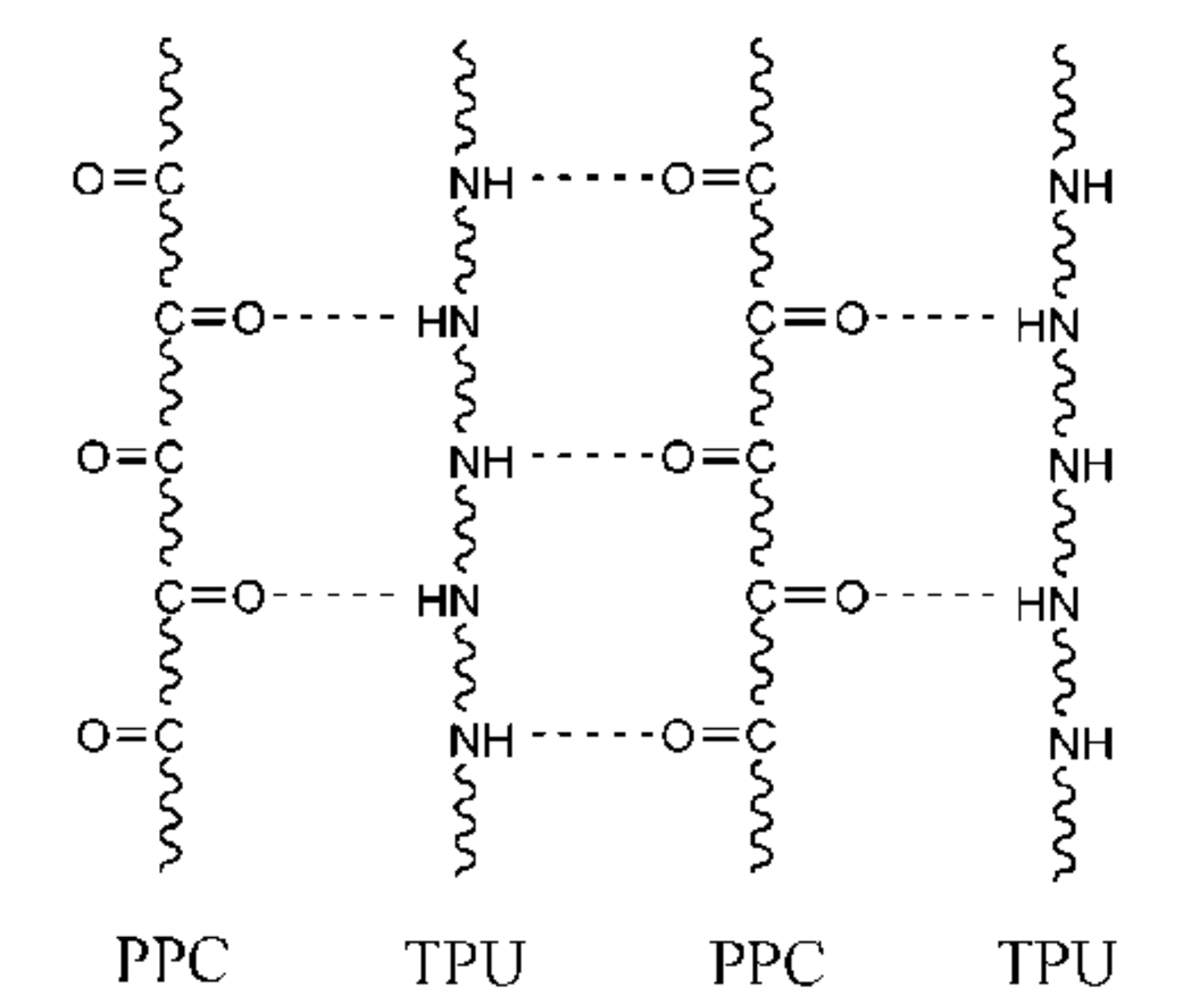
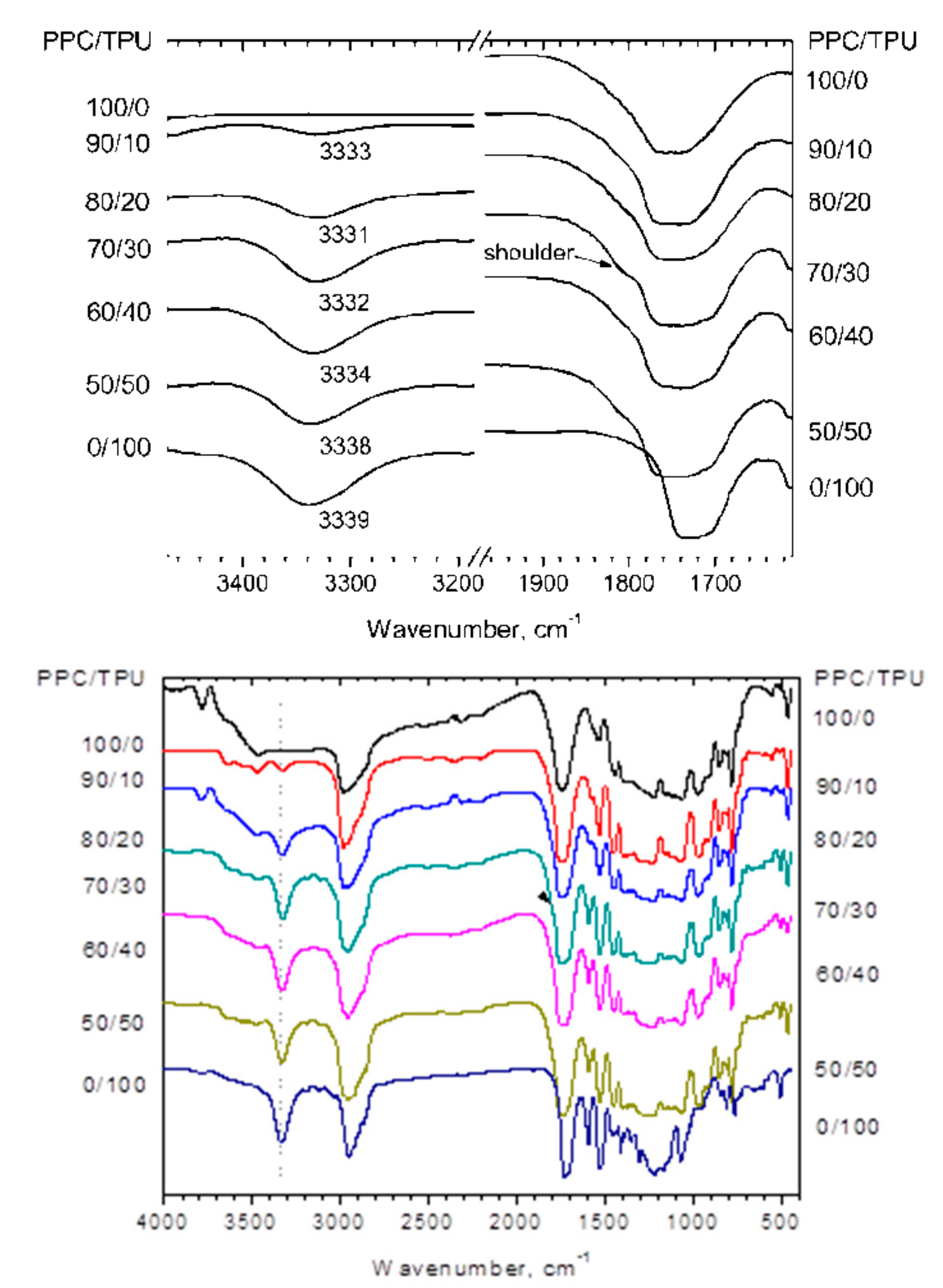
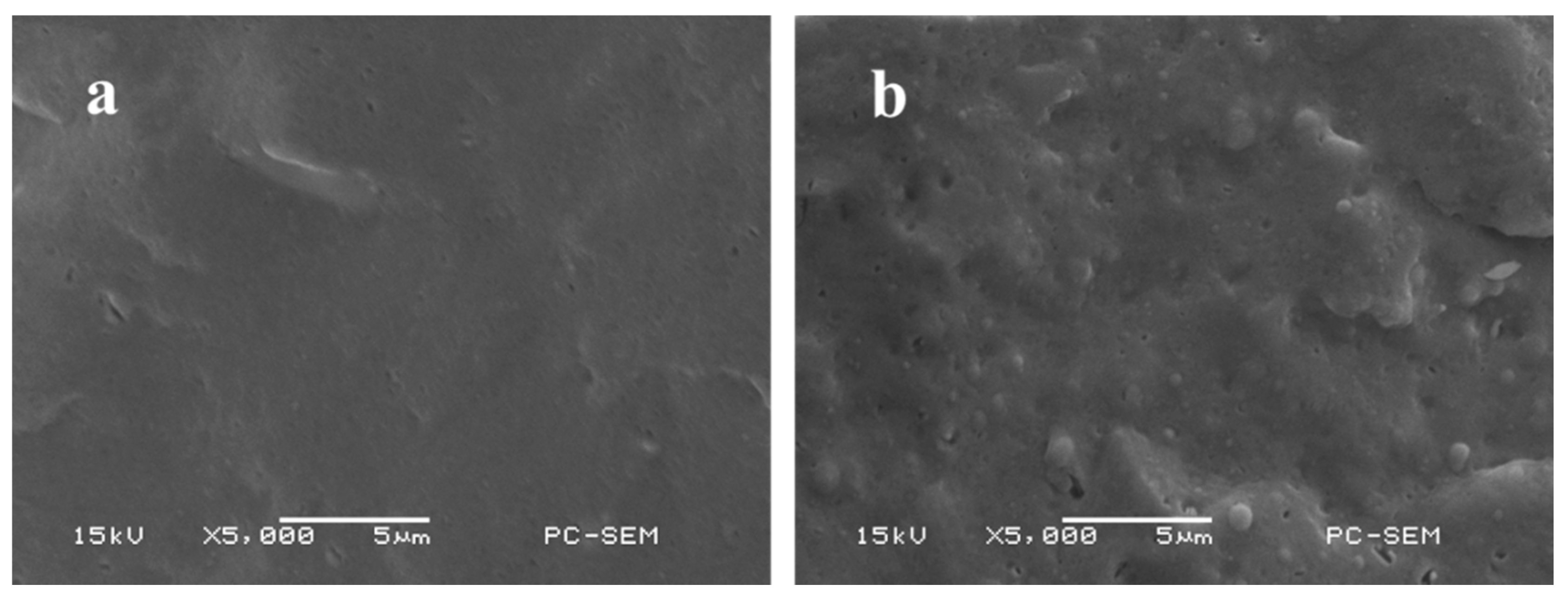
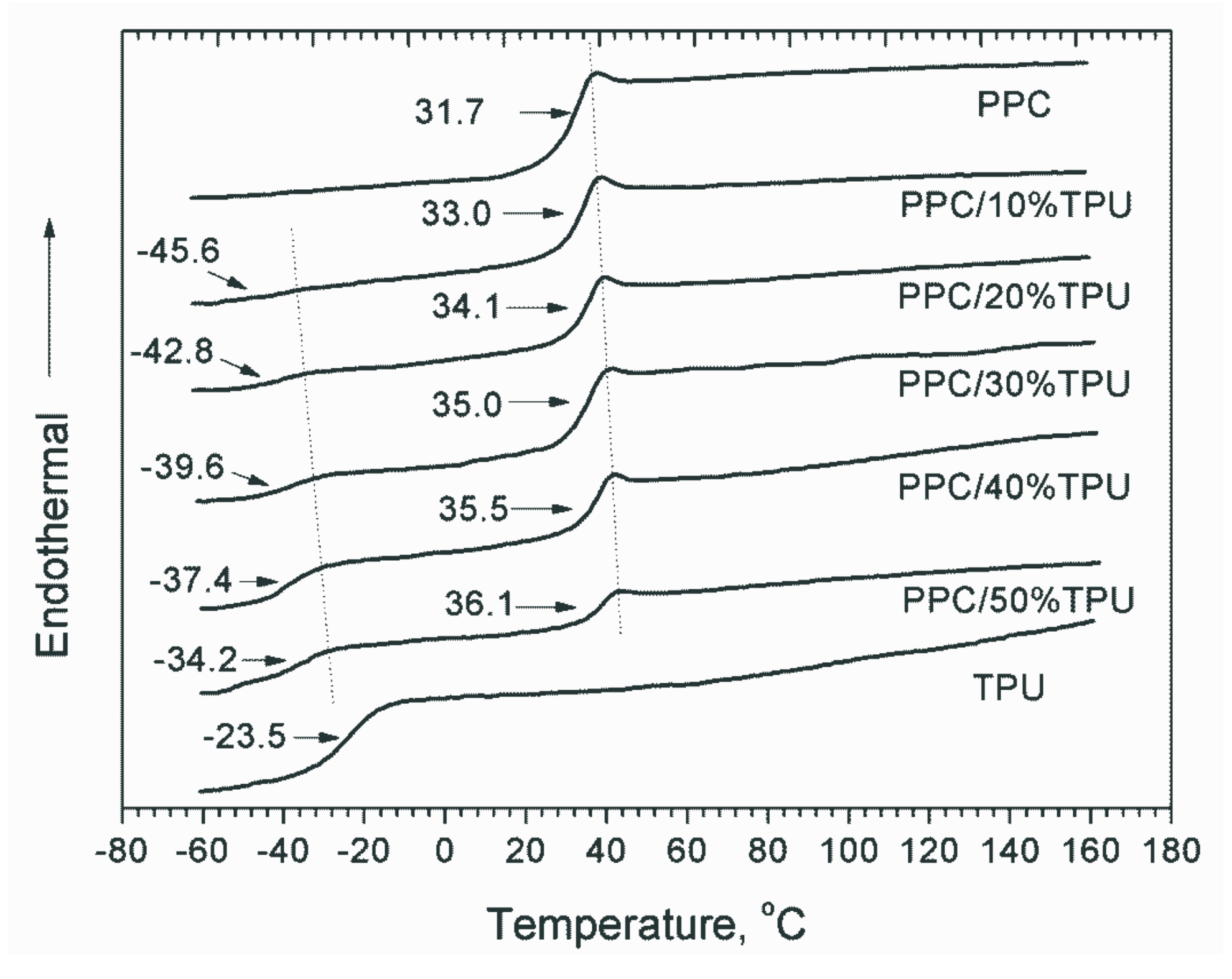
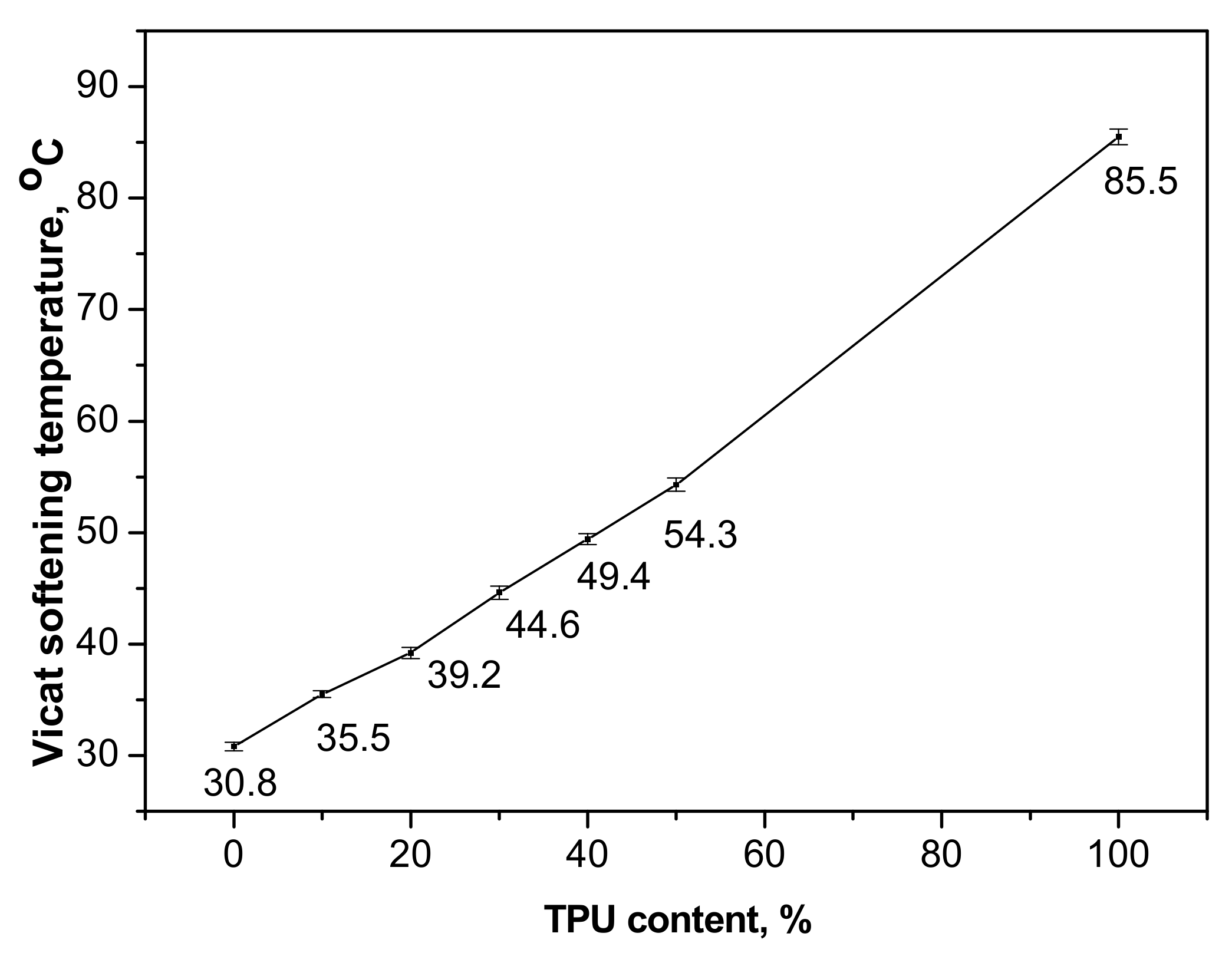
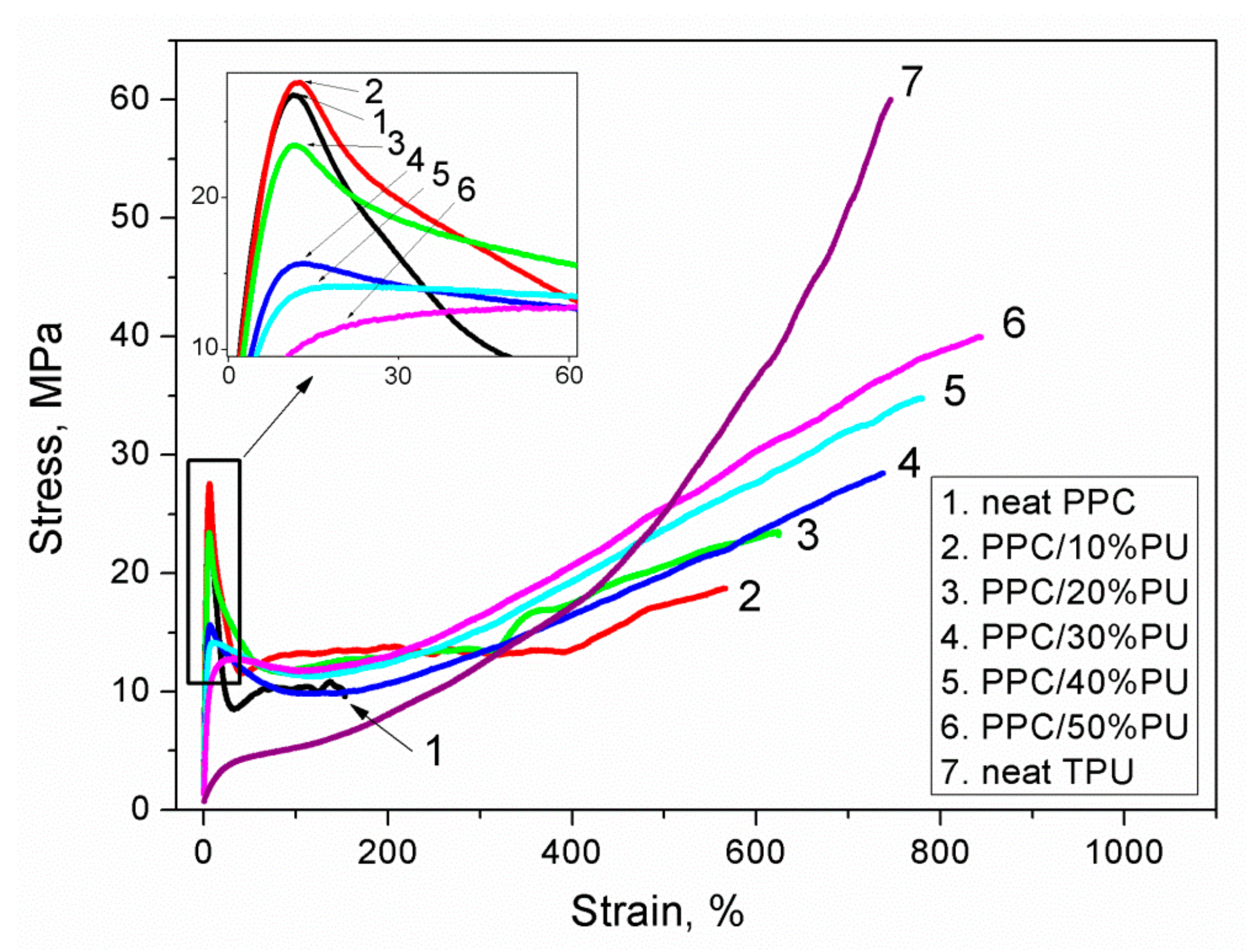
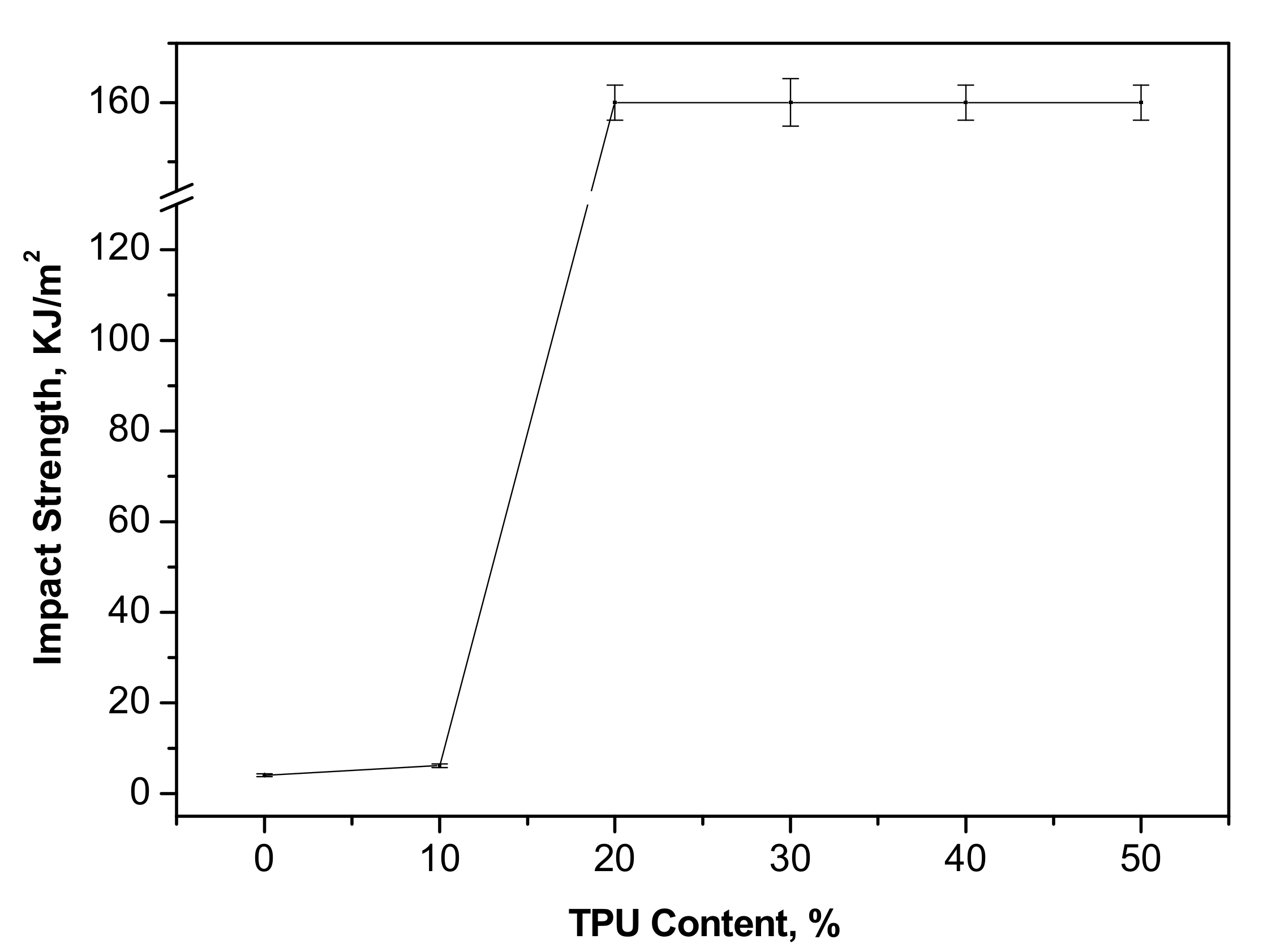
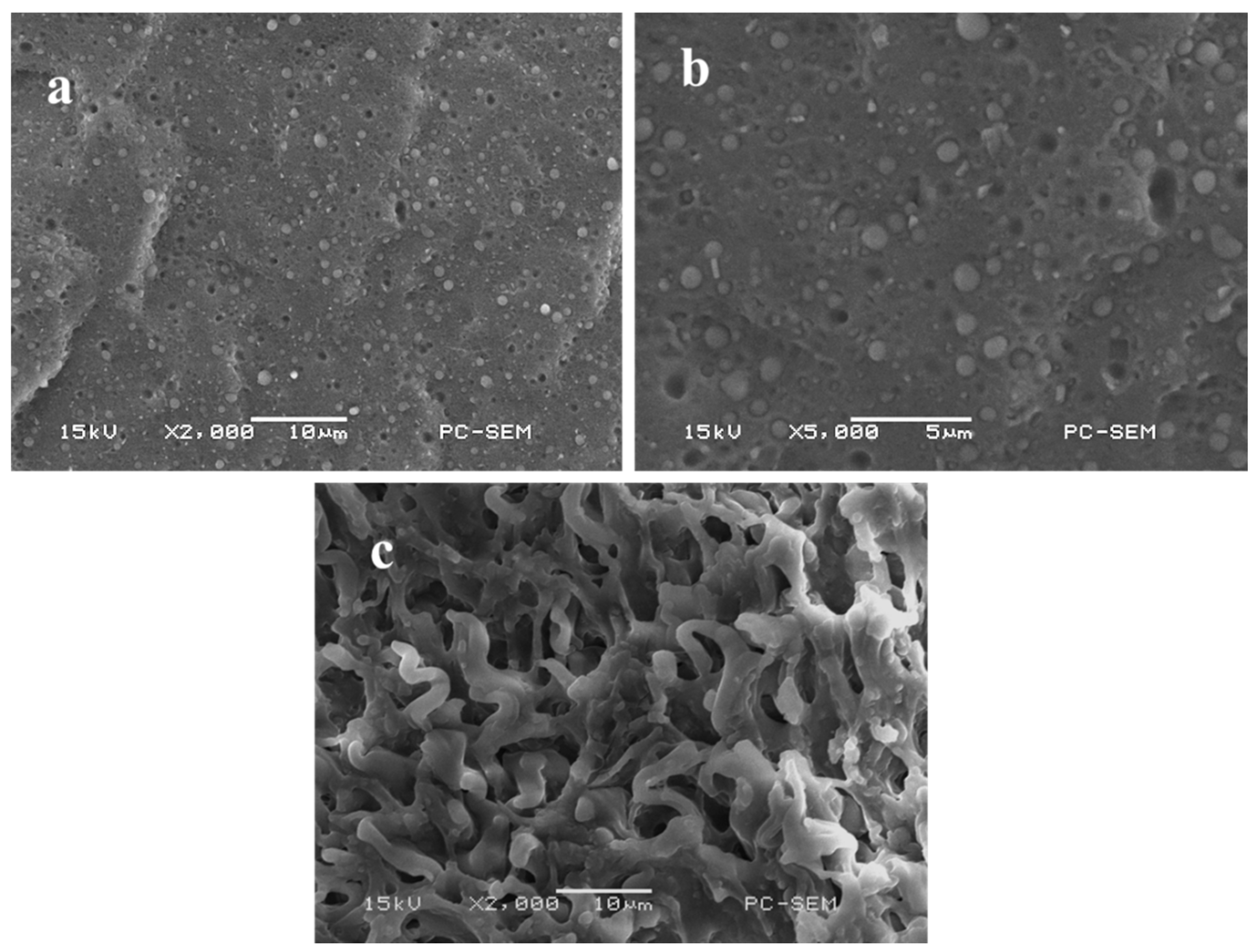
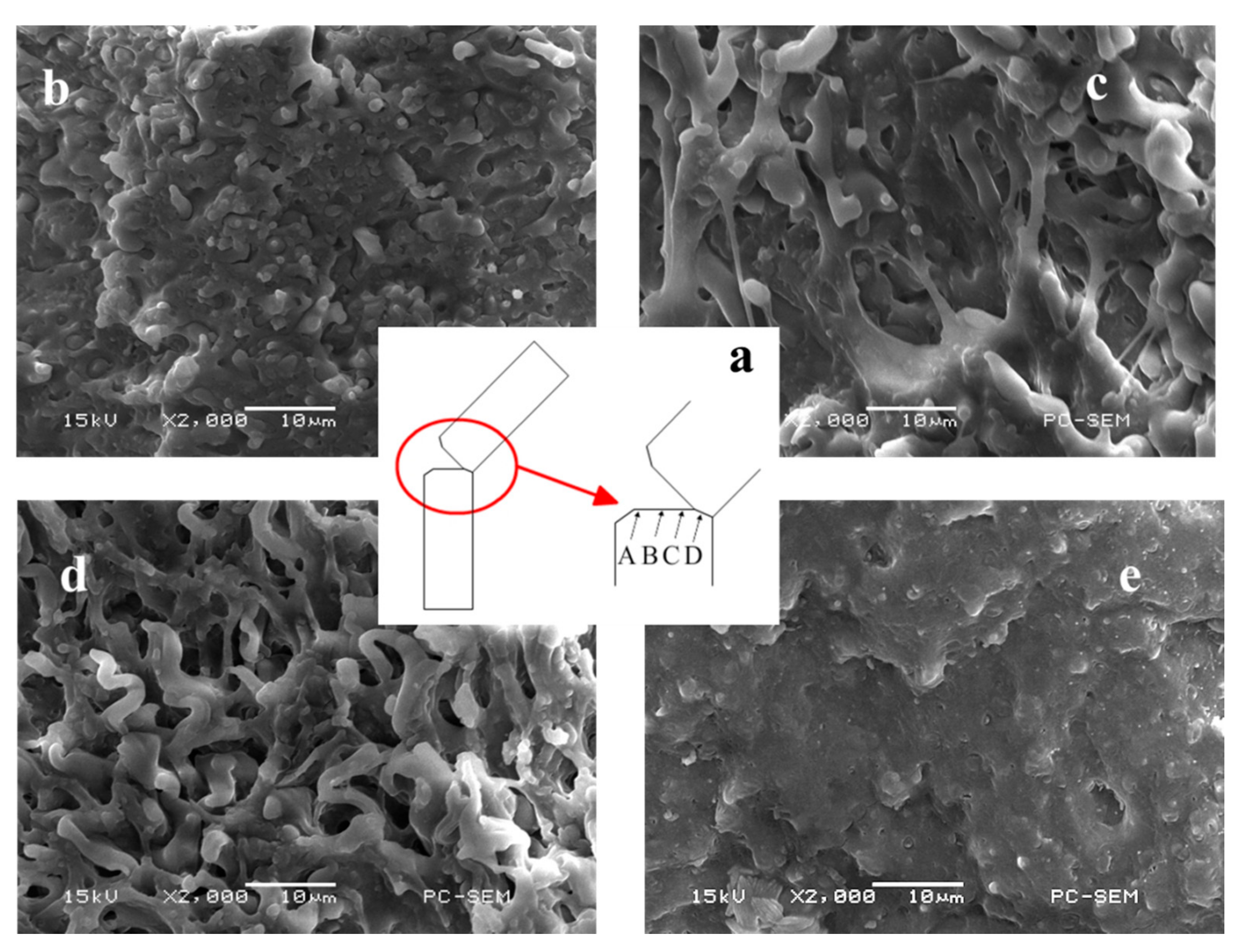

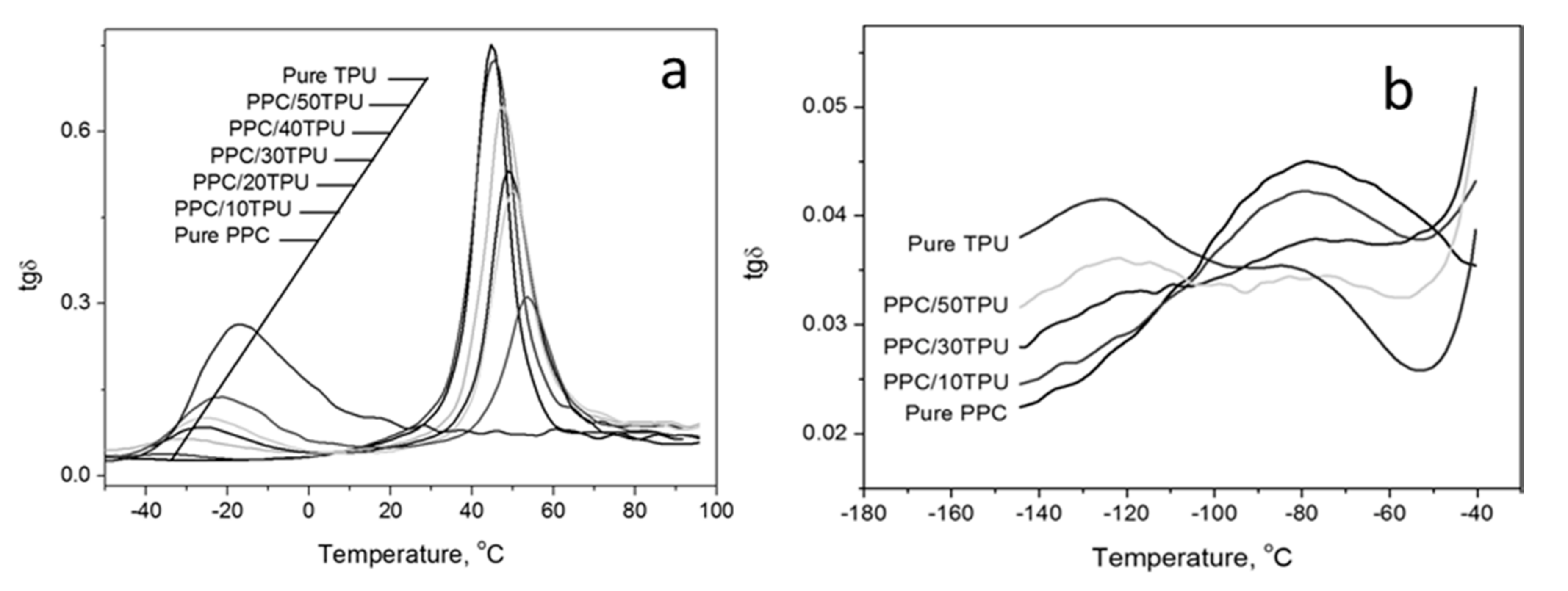
| TPU Content, % | Yield Stress, MPa | Stress at Break, MPa | Elongation at Break, % | Tensile Energy to Break, MJ/m3 | Stress at 100%, MPa | Stress at 200%, MPa | Stress at 300%, MPa |
|---|---|---|---|---|---|---|---|
| 0 | 26.5 ± 1.2 | 9.60 ± 0.6 | 180 ± 20 | 17.1 ± 3 | 10.3 ± 0.3 | - | - |
| 10 | 27.6 ± 0.9 | 18.7 ± 0.7 | 570 ± 30 | 82.2 ± 9 | 13.2 ± 0.2 | 13.8 ± 0.2 | 13.3 ± 0.3 |
| 20 | 23.5 ± 0.8 | 23.2 ± 0.4 | 620 ± 40 | 103 ± 7 | 11.9 ± 0.4 | 12.9 ± 0.3 | 13.5 ± 0.2 |
| 30 | 18.6 ± 0.5 | 27.5 ± 0.7 | 750 ± 50 | 124 ± 11 | 9.9 ± 0.2 | 10.7 ± 0.2 | 13.3 ± 0.2 |
| 40 | 14.3 ± 0.3 | 33.5 ± 2 | 780 ± 30 | 159 ± 9 | 11.4 ± 0.4 | 12.4 ± 0.3 | 15.2 ± 0.4 |
| 50 | 12.8 ± 0.5 | 40.0 ± 3 | 840 ± 50 | 195 ± 14 | 11.8 ± 0.2 | 12.9 ± 0.4 | 16.4 ± 0.4 |
| TPU Content, % | 0 | 10 | 20 | 30 | 40 | 50 | 100 |
|---|---|---|---|---|---|---|---|
| Tg (PPC), °C | 44.7 | 45.4 | 47.5 | 48.9 | 50.2 | 53.5 | - |
| Tg (TPU), °C | - | −35.9 | −31.6 | −26.3 | −24.8 | −22.1 | −16.8 |
© 2018 by the authors. Licensee MDPI, Basel, Switzerland. This article is an open access article distributed under the terms and conditions of the Creative Commons Attribution (CC BY) license (http://creativecommons.org/licenses/by/4.0/).
Share and Cite
Han, D.; Chen, G.; Xiao, M.; Wang, S.; Chen, S.; Peng, X.; Meng, Y. Biodegradable and Toughened Composite of Poly(Propylene Carbonate)/Thermoplastic Polyurethane (PPC/TPU): Effect of Hydrogen Bonding. Int. J. Mol. Sci. 2018, 19, 2032. https://doi.org/10.3390/ijms19072032
Han D, Chen G, Xiao M, Wang S, Chen S, Peng X, Meng Y. Biodegradable and Toughened Composite of Poly(Propylene Carbonate)/Thermoplastic Polyurethane (PPC/TPU): Effect of Hydrogen Bonding. International Journal of Molecular Sciences. 2018; 19(7):2032. https://doi.org/10.3390/ijms19072032
Chicago/Turabian StyleHan, Dongmei, Guiji Chen, Min Xiao, Shuanjin Wang, Shou Chen, Xiaohua Peng, and Yuezhong Meng. 2018. "Biodegradable and Toughened Composite of Poly(Propylene Carbonate)/Thermoplastic Polyurethane (PPC/TPU): Effect of Hydrogen Bonding" International Journal of Molecular Sciences 19, no. 7: 2032. https://doi.org/10.3390/ijms19072032





